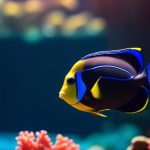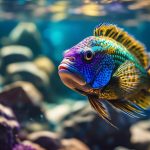The Marbled Hatchetfish, known for its mesmerizing ability to glide through water, is a truly captivating species that has caught the attention of aquarium enthusiasts worldwide. Native to the lush landscapes of South America, these magical blackwater fish possess unique flight-oriented muscles that allow them to navigate their aquatic environment with grace and agility.
But what makes these fish truly enchanting? How can one care for them and provide an environment that meets their specific needs? In this discussion, we will explore the fascinating world of the Marbled Hatchetfish, uncovering the secrets behind their flight-like movements and discovering the key elements to ensure their well-being in an aquarium setting.
Prepare to be intrigued by this wondrous fish as we delve into the captivating realm of the Marbled Hatchetfish.
Key Takeaways
- Marbled Hatchetfish have a lifespan of only two years, so enjoy their presence while they are around.
- Marbled Hatchetfish are part of the Hatchetfish genus, which includes three species: Carnegiella myersi, Carnegiella strigata, and Carnegiella marthae.
- Marbled Hatchetfish have a unique triangular shape and beautiful coloration, with a base color of brown and gold with a silver sheen on top.
- Marbled Hatchetfish are known for their jumping abilities and make excellent community fish, thriving in groups of at least six.
Marbled Hatchetfish Overview
The Marbled Hatchetfish, a fascinating species found in the waters of South America, is known for its unique flying abilities and distinctive appearance. These fish have specific habitat preferences, being found in marshes, brooks, flooded regions, and small rivers in South America. They prefer to swim in the middle layer of the water and hide in the roots of plants when sensing danger.
What sets the Marbled Hatchetfish apart is its remarkable flying abilities. They have powerful muscles that allow them to fly in water, possessing more muscles dedicated to flight than most birds. This enables them to make graceful leaps above the water's surface.
With their habitat preferences and extraordinary flying abilities, the Marbled Hatchetfish is truly a remarkable species.
Lifespan and Hatchetfish Species
Marbled hatchetfish, along with other species in the hatchetfish genus, have a relatively short lifespan of only two years, even with proper care. These fish are known for their unique flying abilities in water, which is facilitated by their powerful muscles.
The hatchetfish genus comprises three species: Carnegiella myersi, Carnegiella strigata, and Carnegiella marthae. These species are found in marshes, brooks, flooded regions, and small rivers in South America. They prefer to swim in the middle layer of the water and hide in the roots of plants when sensing danger.
Despite their short lifespan, marbled hatchetfish and other hatchetfish species are captivating creatures that are worth enjoying while they are around. Breeding habits and natural habitat play a crucial role in the overall well-being and conservation of these remarkable fish.
Tank Requirements and Care

With their unique flying abilities and captivating appearance, proper tank requirements and care are essential for maintaining the health and well-being of hatchetfish species, including the marbled hatchetfish. To ensure a successful and thriving environment for these fish, consider the following tank requirements and care guidelines:
- Water parameters: Maintain a temperature range of 75 to 82 degrees Fahrenheit and a water hardness level of 2-20dGH. Use a reliable water testing kit to regularly monitor and maintain these parameters.
- Tank decoration: Create hiding spots with rocks, driftwood, and plant roots. Disinfect caves before adding them to the tank. Floating plants can provide shade and a sense of security for the fish.
- Breeding techniques: Install dimmed LED lights in the tank to promote breeding and spawning behavior. Proper lighting plays a crucial role in creating an ideal environment for successful reproduction.
Appearance and Size
What are the distinctive physical characteristics of the marbled hatchetfish? The marbled hatchetfish, also known as Carnegiella marthae, has a unique appearance that sets it apart from other fish species. It has a triangular shape when viewed from one side and a rounded shape from the bottom. The base coloration is brown and gold, with a silver sheen on top. The back is dark green with black dots, and there are spots of pink, brown, and light hues on the flank. Two dark stripes run along both sides, and there is a silver line extending from the gills to the caudal fin. On average, the marbled hatchetfish reaches a size of about one and a half inches. However, proper care and a high-quality diet are necessary to achieve this length. The marbled hatchetfish is truly a visually stunning fish that will be a great addition to any aquarium.
| Distinctive Characteristics | Description |
|---|---|
| Shape | Triangular shape from one side and rounded shape from the bottom |
| Coloration | Base coloration of brown and gold with a silver sheen on top; dark green back with black dots, spots of pink, brown, and light hues on the flank; two dark stripes on both sides and a silver line from the gills to the caudal fin |
| Size | Average size of one and a half inches; proper care and high-quality food needed to reach this length |
Behavior and Tank Mates

The behavior of the marbled hatchetfish and its compatible tank mates are important considerations for creating a harmonious and thriving aquarium environment.
- Jumping behavior: Marbled hatchetfish are known for their impressive jumping abilities, which allow them to glide above the water's surface. However, keeping them confined in tanks may prevent them from exhibiting this natural behavior.
- Schooling behavior: These fish thrive when kept in schools of at least six individuals. They are more active and comfortable when raised in a good-sized school, as it mimics their natural behavior in the wild.
When selecting tank mates for marbled hatchetfish, it is crucial to choose species with similar temperament and water parameters. Avoid aggressive fish species and ensure that the tank mates are not larger than the marbled hatchetfish. Compatible tank mates for marbled hatchetfish include Corydoras, crabs, tetras, dwarf cichlids, shrimp, and loricariids.
Marbled Hatchetfish Diet
To ensure the optimal health and well-being of marbled hatchetfish, it is crucial to carefully consider their dietary needs and provide them with a nutritionally balanced and diverse diet.
Marbled hatchetfish are omnivorous, meaning they consume both plant and animal matter. In their natural habitat, they feed on insects, larvae, zooplankton, and other aquatic invertebrates. Therefore, the best food options for marbled hatchetfish include live or frozen invertebrates such as bloodworms, brine shrimp, daphnia, and mosquito larvae. These can be supplemented with high-quality fish flakes and green vegetables.
It is important to prevent overfeeding and ensure that feeding sessions last less than three minutes to avoid food waste and maintain water quality.
Lighting and Tank Decoration

Proper lighting and tank decoration are essential factors to consider when creating a suitable environment for marbled hatchetfish in captivity.
To create a visually appealing tank environment for these unique fish, it is important to focus on the following aspects:
- Dimmed LED lights: Installing dimmed LED lights in the tank can mimic the natural habitat of marbled hatchetfish under the forest canopy. This not only provides a visually pleasing environment but also promotes breeding and spawning behavior.
- Tank decoration: Rocks, driftwood, and plant roots can be utilized to create hiding spots for the fish. Caves should be disinfected before adding them to the tank. Additionally, floating plants can be included to provide shade and a sense of security for the fish.
- Attention to detail: Taking care to arrange the tank decor in a way that resembles the natural environment of marbled hatchetfish can greatly enhance their overall well-being and happiness.
Additional Information
Occasionally, marbled hatchetfish may exhibit a diminished ability to jump when kept in confined tank environments. This is due to the restricted space and lack of vertical clearance, which limits the fish's natural jumping behavior.
To promote breeding and spawning behavior in marbled hatchetfish, dimmed LED lights can be purchased and installed in the tank. Proper lighting helps create a visually appealing tank environment and can stimulate the fish to engage in reproductive activities.
It is important to note that feeding sessions should last less than three minutes to ensure the fish consume all the food.
Keeping marbled hatchetfish in larger, spacious tanks with suitable tank mates can provide them with the freedom and comfort they need to exhibit their natural behaviors.
Blackwing Hatchetfish

The Blackwing Hatchetfish, the smallest species within the hatchetfish genus, is predominantly found in the blackwaters of Colombia and Venezuela. These fish have adapted to thrive in the unique habitats of blackwater rivers and streams.
Here are some key features of the Blackwing Hatchetfish:
- Breeding: Blackwing Hatchetfish are known to be difficult to breed in captivity. They require specific water conditions, such as low pH and soft water, to stimulate breeding behavior. Additionally, providing them with live or frozen food and plenty of hiding spots can increase the chances of successful breeding.
- Blackwater Fish Habitats: Blackwing Hatchetfish are well-suited to blackwater habitats, characterized by acidic water with high levels of tannins. These habitats are typically found in densely forested areas, where decaying leaves and other organic matter create dark, tea-colored water. Blackwing Hatchetfish have evolved to blend in with their surroundings, with their dark coloration providing camouflage from predators.
- Conservation: Due to their restricted range and specific habitat requirements, the Blackwing Hatchetfish is considered vulnerable in the wild. It is important to protect their natural habitats and ensure sustainable collection practices to preserve this unique species for future generations.
Silver Hatchetfish
Continuing our exploration of hatchetfish species, we now turn our attention to the Silver Hatchetfish, a smaller and more shy species found in the blackwaters of South America. The Silver Hatchetfish, also known as the Common Hatchetfish, can be found in the Amazon River Basin, West Peru, and Venezuela. These fish have specific habitat preferences and are typically found in slow-moving waters with dense vegetation, such as flooded forests and small rivers. They prefer dimly lit tanks to mimic their natural habitat under the forest canopy.
In terms of breeding habits, Silver Hatchetfish are egg scatterers. During the breeding season, which can be stimulated by proper lighting conditions, males and females will engage in courtship behaviors. The female will release her eggs, and the male will then fertilize them. The eggs are adhesive and will attach to plants or other surfaces. After hatching, the fry are initially small and fragile, requiring special care and attention to ensure their survival.
Frequently Asked Questions
How High Can Marbled Hatchetfish Actually Jump Out of the Water?
Marbled hatchetfish, known for their jumping abilities, can leap out of the water up to several inches. This behavior is a natural defense mechanism to escape predators. In their natural habitat, they prefer dimly lit tanks and thrive when kept in schools.
Can Marbled Hatchetfish Be Kept With Aggressive Fish Species?
Marbled hatchetfish should not be kept with aggressive fish species. They are best suited to peaceful tank mates with similar temperament and water parameters, such as Corydoras, tetras, shrimp, and loricariids. Breeding marbled hatchetfish can be promoted with the installation of dimmed LED lights.
Do Marbled Hatchetfish Require a Specific Water Hardness Level in Their Tank?
Marbled hatchetfish thrive in water with a water hardness level ranging from 2-20dGH. When considering tank mates, it is important to choose peaceful fish species that have similar water parameters to ensure compatibility.
What Is the Recommended Tank Size for a School of Marbled Hatchetfish?
The recommended tank size for a school of Marbled Hatchetfish is at least 15 gallons. It is important to provide ideal tank conditions, such as dimly lit environment and suitable tankmates like Corydoras, tetras, and shrimp.
Are Marbled Hatchetfish Prone to Any Specific Diseases or Health Issues?
Marbled Hatchetfish have a lifespan of 2 years. To properly feed them, offer live or frozen food such as insects, larvae, and zooplankton. Dim lighting and proper tank mates are crucial for their well-being.










